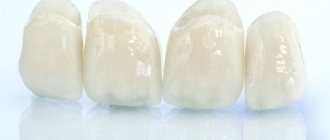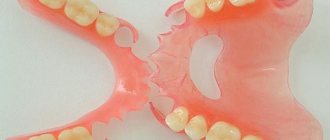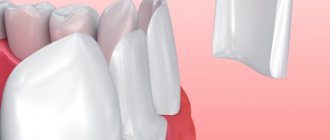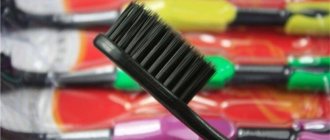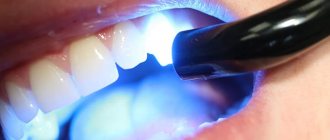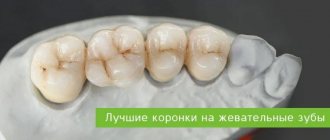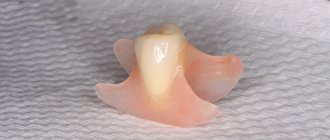Chief editor of the site:
Snitkovsky Arkady Alexandrovich
Chief physician of the professorial dentistry “22 Century”, dentist, orthopedic dentist
Author of the article:
Scientific team of dentistry “22 Century”
Dentists, candidates and doctors of medical sciences, professors
One of the classic methods of prosthetics in dentistry is gold crowns on the tooth.
One of the classic methods of prosthetics in dentistry is gold crowns on the tooth . This is a relatively inexpensive (no more expensive than metal-ceramics and ceramic crowns) option for restoring a damaged tooth, reliable and durable.
The effectiveness of prosthetics using gold crowns and their affordability make them a worthy alternative to metal-ceramics . At the 22nd Century clinic, dental prosthetics using gold crowns is widely practiced.
What it is
Gold crowns are “caps” made of dental gold 900 and placed on the teeth to restore chewing functions. They can be used to correct the defect of a single tooth, or to replace several missing teeth using a metal bridge.
Gold has been used in dentistry for centuries and this is not an accident. This metal does not cause negative reactions from the body, is not subject to oxidation under the influence of saliva, and does not cause allergic reactions. At the same time, it is quite durable and can withstand even significant chewing loads.
Hygiene measures
No special conditions are required to maintain operation. Cleaning is carried out with a toothbrush with soft bristles, sweeping movements in the direction from the gums to the free edge. Plaque on the surface of the alloy practically does not accumulate due to the smoothness of the coating.
You should use floss or dental floss to remove food debris from the interdental spaces. For convenience, you can purchase an irrigator - a device that cleans with a thin stream of water.
Advantages and disadvantages
Advantages of false teeth made of gold:
- High biocompatibility with tissues of the human body. Gold does not cause the development of allergic reactions, is not toxic and does not provoke discoloration of the gums and enamel of adjacent teeth.
- Under the influence of oxidizing agents, gold crowns do not corrode and do not oxidize in the mouth. Therefore, they do not change the taste of saliva and cannot cause the development of an unpleasant odor.
- The sufficient softness of the metal makes it possible to produce crowns that exactly match the tooth being prosthetized and fit tightly to the supporting dense tissues.
- Gold has a high strength coefficient, does not chip and can withstand constant intense loads, so it is ideal for prosthetics of chewing teeth.
- Long service life. With proper prosthetics and proper care, gold crowns can last up to 15 years or more.
- Gold teeth have the same abrasion coefficient as natural enamel, so such dentures do not cause damage to the hard tissues of antagonist teeth.
- The anti-inflammatory effect is a reliable prevention of caries of supporting teeth under crowns.
But, despite the large number of advantages, several disadvantages of gold teeth can be noted:
- The low aesthetics of gold structures makes them undesirable for dental prosthetics in the visible smile area.
- The need to prepare a tooth for a crown is due to the fact that it is necessary to remove part of the hard dental tissues to ensure a tight fit of the metal structure. In addition, the gold prosthesis has a certain thickness that must be turned.
- The cost of gold false teeth is quite high.
Gold - why not!
Gold can only be dissolved in “aqua regia” - a mixture of concentrated hydrochloric and nitric acids.
This chemical inertness of this metal means that from a medical point of view, placing gold crowns is completely safe. Advantages of gold prostheses:
- Hypoallergenic
- The risk of caries is reduced, which is facilitated by the precision of the fit and the softness of the metal
- The thickness of the crown wall is small, so there is no need to prepare the tooth for it.
- Gold melts at temperatures above 10,000C, meaning hot foods and drinks will not cause an unpleasant taste or other unpleasant sensations in the mouth
For certain types of diseases or a tendency to allergic reactions, it is recommended to install only gold crowns.
For periodontal diseases, chronic gum inflammation, pathologies of the kidneys and endocrine system, it is recommended to install only gold dentures or crowns. The same advice applies to persons with an allergic reaction to alloys used in dentistry.
For the first time, in 1728, the French doctor Pierre Fauchard made a gold crown in the form of a cap and covered it with porcelain. At that historical period, such a product was very expensive and was a sign of high status in the society of its owner.
Manufacturing
Gold metal crowns are of the solid-cast type and are manufactured in several stages:
- After preparing the oral cavity and grinding the teeth, impressions are made of the dentition of the upper and lower jaw.
- In the laboratory, based on impressions, plaster models are made, which serve as a standard and an exact copy of the patient’s dental characteristics for the technician.
- In accordance with the plaster model, wax copies of future crowns are made, which are sent to the dentist’s office for fitting and adjustment.
- If the patient and doctor are satisfied with everything in the wax model, then the final gold crowns are cast on its basis, which are then ground and polished.
»
Possible problems after prosthetics
Even with high-quality work by doctors and patient compliance with all rules, side effects from prosthetics may occur. They are rare, but the main consequences include:
- Discomfort when eating food. After teeth restoration, it is recommended to refrain from consuming solid foods for 2-3 days: chips, crackers, apples, so that the jaw muscles have time to adapt to the changed chewing load.
- Increased sensitivity of the dentin of the restored unit. The situation occurs after the pulp is removed from the tooth before its preparation. The symptom does not indicate any complications and can be relieved with pastes for sensitive enamel.
Installation
The process of installing gold crusts takes several visits to the dentist’s office:
- At the first visit to the doctor’s office, the patient’s oral health is examined, caries is treated and, if necessary, old fillings are replaced. The dentist grinds the tooth on which the gold structure will be installed. In this case, dense dental tissues are ground down within 1 mm, when for metal-ceramic dentures this figure reaches 2 mm.
- After making impressions, the doctor makes a temporary overlay plastic prosthesis on site, which protects the tissues of the supporting tooth and performs an aesthetic function.
- At the second visit, the dentist tries on a wax model of the prosthesis for the patient, adjusting it and correcting any identified deficiencies.
- During the patient's third visit to the doctor, the final gold crown is tried on and fixed with temporary cement for up to three months. This is necessary in order to finally verify the correctness of manufacture and the comfort of the design.
- After 3 months, the crown is removed, cleaned of cement residues, and its effect on soft tissue is checked. If there are no contraindications, the gold prosthesis is fixed to permanent composite materials.
You can get crowns on your teeth in Moscow at a cost-effective rate at Dantistoff Scientific Dentistry. Orthopedic dentists, candidates of sciences of the highest category. Sign up.
Is gold coming back?
News flashed on the Internet: scientists at Tashkent University are working on the Goldtooth project - a kind of analogue of Bluetooth wireless communication. The carrier of the transmitting module will not be a pocket computer, but a gold crown filled with smart technology. The owner of such a crown will be able to speak on a mobile phone without taking it out of his pocket, dictate letters by voice for email, access the Internet, connect to wireless local networks...
This is how the cell phone conversation mechanism works. Sound enters the crown using a digital radio signal, which transmits it through a bone resonator to the inner ear. The sound is heard only by one person - the one to whom it is addressed, so you can use the “dental phone” anywhere and at any time.
In the future, such a tooth will allow its owner to pay for goods and a special sensor on the cash register. After all, a unique design can be applied to each such crown and thus identify its owner. Some banks are already ready to open special accounts.
The project manager predicts that the new service - it will be called smart prosthetics - will bring back the fashion for gold teeth.
Life time
Gold crowns are considered one of the most durable dentures. If such structures are made correctly and are ideally suited for a person, as well as with proper care for them, their service life on average reaches 15 years. But there are often cases when such crowns do not need to be replaced or repaired even after 20-25 years.
Gold crowns are reliable and durable structures, but only a dentist can correctly assess the possibility of installing them for each patient. When choosing one or another method of prosthetics, you need to listen to the opinion of a specialist.
Where to sell the 850
Dental samples are accepted at pawn shops. They buy crowns at a reduced price as scrap precious metals. Pawn shops apply deductions for dirt. Before being sold to a pawn shop, crowns are cleaned of plaque and dental material. It is recommended to call pawn shops in advance to find out the conditions for accepting crowns.
Pawn shops do not accept gold-plated teeth coated with gold.
The purchase of the eight hundred and fiftieth is carried out by illegal buyers. The purchase price will be as low as possible. Gold crowns are accepted by jewelry workshops for melting down and further use.
Reviews
Gold crowns are often used in dental practice due to their strength and reliability.
At the same time, in terms of aesthetic indicators, these products are inferior to metal-ceramic and zirconium analogues.
Sources:
- https://mnogozubov.ru/zolotye-koronki-na-zuby/
- https://esculapdent.ru/services/zolotye-koronki
- https://dr-zubov.ru/ortopediya/nesemnye-protezy/koronki/sovremennye-raznovidnosti-zolotyx.html
- https://www.vash-dentist.ru/protezirovanie/nesemnyie-p/koronki-np/zolotyie.html
- https://stoma.click/ortodontia/protezi/zolotye-koronki.html
- https://AcademiaDent.ru/info/zolotye-koronki-na-zuby/
- https://me-dent.ru/protezirovanie/koronki/vstavit-zolotoj-zub
- https://protezi-zubov.ru/koronki/zolotye/
Is it possible to remove
There are situations when early crown removal may be necessary. Indications for this action are as follows:
- the occurrence of inflammation in the oral cavity;
- formation of cracks, chips or complete damage to the surface of the product;
- lack of preliminary sanitation of the oral cavity, as a result of which carious lesions of the tooth developed;
- bite problems;
- expiration of the installed crown.
The product is removed in the dental office using special devices.
Indications
Installation of crowns made on the basis of noble metal is indicated in the following cases:
- with pathological abrasion of enamel;
- if necessary, restore the anatomical shape of the tooth;
- to strengthen and restore the functionality of your own molars.
Find out the cost of tooth extension on a pin and in what cases this procedure is advisable. Read doctors' reviews about Ankylos implants here.
This address https://dr-zubov.ru/lechenie/zuby/kakie-prichiny-vedut-k-razrusheniyu.html contains material about the causes of tooth enamel destruction in children.
Rehabilitation
The adaptation period after prosthetics has no specific features. In most cases, upon leaving the dentist's office, the patient can immediately eat and drink. It all depends on the type of composite material used during installation.
The only thing a specialist can ask you to do is to refrain from eating solid food for the first days. In order for the cement to harden better.
What are metal-plastic crowns, stages of manufacturing and installation.
In this article we offer reviews from dentists about Akri Free dentures.
Follow the link https://zubovv.ru/protezirovanie/nesemnyie-p/koronki-np/tsirkonievyie-na-perednie-otzyivyi-stoimost-opisanie.html if you are interested in the process of making a zirconium crown for a front tooth.
Removal
Sometimes situations arise when it is necessary to remove the crown.
This happens in the following cases:
- the occurrence of complications or inflammation in the oral cavity;
- replacing the crown if a crack, hole appears on it, or the structure as a whole is damaged;
- poor-quality preparation of the oral cavity before prosthetics (poorly sealed canals);
- occurrence of problems of the oral cavity of a physiological nature (bite distortion, aesthetic disturbances);
- when its expiration date has expired .
If the crown is severely damaged or has expired, it is sawed and removed.
When it is necessary to preserve the structure, the crown can be removed using :
- crown removers - special manual or automatic tools;
- forceps>;
- ultrasonic installation , which, acting on the connection of the structure, destroys the cement, after which the prosthesis is easily removed.
- pneumatic instruments , with which the orthopedist destroys the connective cement.
Prices
The main criterion for determining the cost of a prosthesis is the price of a gram of precious metal for the period of manufacture of the structure.
In addition, the amount of turnkey work also includes the costs of preparatory procedures for the oral cavity for prosthetics, which are individual for each patient.
The price is also affected by the type of structure, the cost of which ranges from:
- 7-10 thousand rubles for full models;
- 5-7 thousand rubles for half-crowns;
- 10-12 thousand rubles for equatorial products;
- 12-13 thousand rubles for stump inlays;
- 25-29 thousand rubles for a metal-ceramic coating with a gold alloy;
- 40-45 thousand rubles for a structure with a pin.

